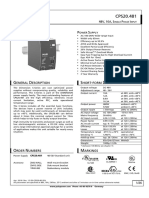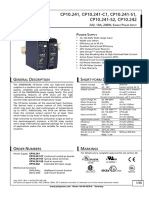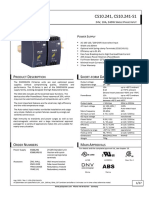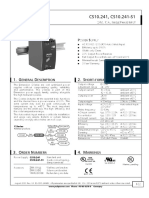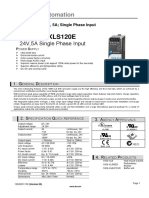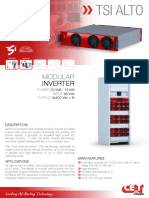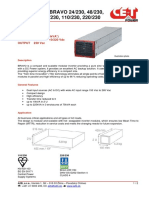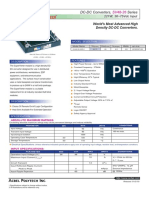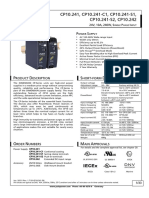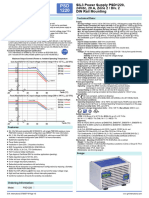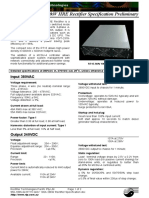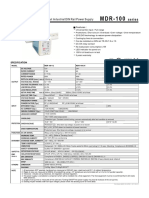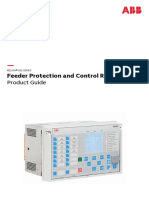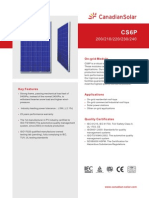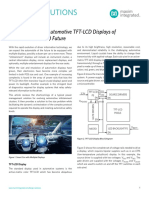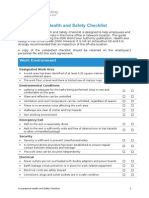Qs20e241 c1
Qs20e241 c1
Uploaded by
Kislan MislaCopyright:
Available Formats
Qs20e241 c1
Qs20e241 c1
Uploaded by
Kislan MislaOriginal Title
Copyright
Available Formats
Share this document
Did you find this document useful?
Is this content inappropriate?
Copyright:
Available Formats
Qs20e241 c1
Qs20e241 c1
Uploaded by
Kislan MislaCopyright:
Available Formats
QS20.241, QS20.241-A1, QS20.
241-C1
Q-Series 24V, 20A, SINGLE PHASE INPUT
POWER SUPPLY
AC 100-240V Wide-range Input
Width only 82mm
Efficiency up to 93.9%
ATEX and IECEx Approved (-A1 Version)
-C1 Version with Conformal Coated PC-board
150% (720W) Peak Load Capability
Safe HiccupPLUS Overload Mode
Easy Fuse Tripping due to High Overload Current
Active Power Factor Correction (PFC)
Negligible low Inrush Current Surge
Short-term Operation down to 60Vac and up to 300Vac
Full Power Between -25°C and +60°C
DC-OK Relay Contact
Quick-connect Spring-clamp Terminals
3 Year Warranty
GENERAL DESCRIPTION SHORT-FORM DATA
The most outstanding features of this Dimension Q- Output voltage DC 24V
Series DIN-rail power supply are the high efficiency and Adjustment range 24 - 28V
the small size, which are achieved by a synchronous
Output current 20 – 17A continuous
rectification and further novel design details.
30 – 26A for typ. 4s
With short-term peak power capability of 150% and Output power 480W continuous
built-in large sized output capacitors, these features
720W for typ. 4s
help start motors, charge capacitors and absorb reverse
Output ripple < 100mVpp 20Hz to 20MHz
energy and often allow a unit of a lower wattage class
to be used. Input voltage AC 100-240V ±15%
Mains frequency 50-60Hz ±6%
High immunity to transients and power surges as well as
low electromagnetic emission makes usage in nearly AC Input current 4.56 / 2.48A at 120 / 230Vac
every environment possible. Power factor 0.95 / 0.90 at 120 / 230Vac
AC Inrush current typ. 9 / 7A peak at 120 / 230Vac
The integrated output power manager, a wide range
input voltage design and virtually no input inrush Efficiency 92.4 / 93.9% at 120 / 230Vac
current make installation and usage simple. Diagnostics Losses 39.6 / 31.4W at 120 / 230Vac
are easy due to the dry DC-ok contact, a green DC-ok Temperature range -25°C to +70°C operational
LED and red overload LED. Derating 12W/°C +60 to +70°C
Unique quick-connect spring-clamp terminals allow a Hold-up time typ. 32 / 51ms at 120 / 230Vac
safe and fast installation and a large international Dimensions 82x124x127mm WxHxD
approval package for a variety of applications makes
this unit suitable for nearly every situation.
ORDER NUMBERS MARKINGS
Power Supply QS20.241 24-28V Standard unit
QS20.241-A1 ATEX approved unit
QS20.241-C1 Conformal coated unit IND. CONT. EQ.
UL 60950-1
UL 508 Class I Div 2 Marine
Accessory ZM2.WALL Wall mount bracket
ZM15.SIDE Side mount bracket
YR40.242 Redundancy module IECEx ATEX
YR40.245 Redundancy module II 3G Ex ec nC II T3 Gc EMC, LVD, RoHS
Sep. 2019 / Rev. 2.3 DS-QS20.241-EN
All parameters are specified at 24V, 20A, 230Vac, 25°C ambient and after a 5 minutes run-in time unless otherwise noted. 1/26
www.pulspower.com Phone +49 89 9278 0 Germany
QS20.241, QS20.241-A1, QS20.241-C1
Q-Series 24V, 20A, SINGLE PHASE INPUT
INDEX
Page Page
1. Intended Use .......................................................3 21. Accessories ........................................................ 19
2. Installation Requirements ...................................3 21.1. ZM2.WALL Wall Mounting Bracket ....... 19
3. AC-Input...............................................................4 21.2. ZM15.SIDE Side Mounting Bracket ........ 19
4. DC-Input...............................................................5 21.3. YR40 Redundancy Modules ..................... 20
5. Input Inrush Current ...........................................5 22. Application Notes ............................................. 21
6. Output .................................................................6 22.1. Repetitive Pulse Loading .......................... 21
7. Hold-up Time .......................................................8 22.2. Peak Current Capability ........................... 22
8. DC-OK Relay Contact ..........................................8 22.3. Back-feeding Loads .................................. 22
9. Efficiency and Power Losses................................9 22.4. External Input Protection ......................... 22
10. Lifetime Expectancy and MTBF.........................10 22.5. Charging of Batteries ............................... 23
11. Functional Diagram...........................................10 22.6. Output Circuit Breakers............................ 23
12. Terminals and Wiring ........................................11 22.7. Parallel Use to Increase Output Power .... 24
13. Front Side and User Elements ...........................12 22.8. Parallel Use for Redundancy .................... 24
14. EMC ....................................................................13 22.9. Series Operation ....................................... 25
15. Environment ......................................................14 22.10. Inductive and Capacitive Loads................ 25
16. Protection Features ...........................................15 22.11. Operation on Two Phases ........................ 25
17. Safety Features ..................................................15 22.12. Use in a Tightly Sealed Enclosure ............ 25
18. Dielectric Strength ............................................16 22.13. Mounting Orientations ............................ 26
19. Approvals ...........................................................17
20. Physical Dimensions and Weight ......................18
The information presented in this document is believed to be accurate and reliable and may change without notice.
No part of this document may be reproduced or utilized in any form without permission in writing from the publisher.
TERMINOLOGY AND ABREVIATIONS
PE and symbol PE is the abbreviation for Protective Earth and has the same meaning as the symbol .
Earth, Ground This document uses the term “earth” which is the same as the U.S. term “ground”.
T.b.d. To be defined, value or description will follow later.
AC 230V A figure displayed with the AC or DC before the value represents a nominal voltage with
standard tolerances (usually ±15%) included.
E.g.: DC 12V describes a 12V battery disregarding whether it is full (13.7V) or flat (10V)
230Vac A figure with the unit (Vac) at the end is a momentary figure without any additional
tolerances included.
50Hz vs. 60Hz As long as not otherwise stated, AC 230V parameters are valid at 50Hz mains frequency.
may A key word indicating flexibility of choice with no implied preference.
shall A key word indicating a mandatory requirement.
should A key word indicating flexibility of choice with a strongly preferred implementation.
Sep. 2019 / Rev. 2.3 DS-QS20.241-EN
All parameters are specified at 24V, 20A, 230Vac, 25°C ambient and after a 5 minutes run-in time unless otherwise noted. 2/26
www.pulspower.com Phone +49 89 9278 0 Germany
QS20.241, QS20.241-A1, QS20.241-C1
Q-Series 24V, 20A, SINGLE PHASE INPUT
1. INTENDED USE
This device is designed for installation in an enclosure and is intended for the general use such as in industrial control,
office, communication, and instrumentation equipment.
Do not use this power supply in equipment, where malfunction may cause severe personal injury or threaten human
life.
This device is designed for use in hazardous, non-hazardous, ordinary or unclassified locations.
2. INSTALLATION REQUIREMENTS
This device may only be installed and put into operation by qualified personnel.
This device does not contain serviceable parts. The tripping of an internal fuse is caused by an internal defect.
If damage or malfunction should occur during installation or operation, immediately turn power off and send unit to
the factory for inspection.
Mount the unit on a DIN-rail so that the output terminals are located on the top and the input terminals are located
on the bottom of the unit. For other mounting orientations see de-rating requirements in this document. See chapter
22.13.
This device is designed for convection cooling and does not require an external fan. Do not obstruct airflow and do
not cover ventilation grid (e.g. cable conduits) by more than 30%!
Keep the following installation clearances: 40mm on top, 20mm on the bottom, 5mm on the left and right sides are
recommended when the device is loaded permanently with more than 50% of the rated power. Increase this clearance
to 15mm in case the adjacent device is a heat source (e.g. another power supply).
A disconnecting means shall be provided for the output of the power supplies when used in applications according to
CSA C22.2 No 107.1-01.
WARNING Risk of electrical shock, fire, personal injury or death.
- Do not use the power supply without proper grounding (Protective Earth). Use the terminal on the input block for
earth connection and not one of the screws on the housing.
- Turn power off before working on the device. Protect against inadvertent re-powering.
- Make sure that the wiring is correct by following all local and national codes.
- Do not modify or repair the unit.
- Do not open the unit as high voltages are present inside.
- Use caution to prevent any foreign objects from entering the housing.
- Do not use in wet locations or in areas where moisture or condensation can be expected.
- Do not touch during power-on, and immediately after power-off. Hot surfaces may cause burns.
Notes for use in hazardous location areas:
The power supply is suitable for use in Class I Division 2 Groups A, B, C, D locations.
Additionally, the QS20.241-A1 is suitable for use in Group II Category 3 (Zone 2) environments and is evaluated
according to EN 60079-0:2009 and EN 60079-15:2010.
WARNING EXPLOSION HAZARDS!
Substitution of components may impair suitability for this environment. Do not disconnect the unit or operate the
voltage adjustment unless power has been switched off or the area is known to be non-hazardous.
A suitable enclosure must be provided for the end product which has a minimum protection of IP54 and fulfils the
requirements of the EN 60079-15.
Sep. 2019 / Rev. 2.3 DS-QS20.241-EN
All parameters are specified at 24V, 20A, 230Vac, 25°C ambient and after a 5 minutes run-in time unless otherwise noted. 3/26
www.pulspower.com Phone +49 89 9278 0 Germany
QS20.241, QS20.241-A1, QS20.241-C1
Q-Series 24V, 20A, SINGLE PHASE INPUT
3. AC-INPUT
AC input nom. AC 100-240V suitable for TN-, TT- and IT mains networks
AC input range min. 85-276Vac continuous operation
min. 60-85Vac full power for 200ms, no damage between 0 and 85Vac
min. 276-300Vac < 500ms
Allowed voltage L or N to earth max. 276Vac continuous, IEC 62103
Input frequency nom. 50–60Hz ±6%
Turn-on voltage typ. 77Vac steady-state value, see Fig. 3-1
Shut-down voltage typ. 73Vac steady-state value, see Fig. 3-1
typ. 53Vac dynamic value
AC 100V AC 120V AC 230V
Input current typ. 5.47A 4.56A 2.48A at 24V, 20A, see Fig. 3-3
Power factor *) typ. 0.96 0.95 0.90 at 24V, 20A, see Fig. 3-4
Crest factor **) typ. 1.6 1.7 2.05 at 24V, 20A
Start-up delay typ. 640ms 610ms 660ms see Fig. 3-2
Rise time typ. 80ms 80ms 80ms 0mF, 24V, 20A, see Fig. 3-2
typ. 85ms 85ms 85ms 20mF, 24V, 20A, see Fig. 3-2
Turn-on overshoot max. 100mV 100mV 100mV see Fig. 3-2
*) The power factor is the ratio of the true (or real) power to the apparent power in an AC circuit.
**) The crest factor is the mathematical ratio of the peak value to RMS value of the input current waveform.
Fig. 3-1 Input voltage range Fig. 3-2 Turn-on behavior, definitions
Rated
POUT input range max.
Input
500ms Voltage
full
power
for
200ms
Shut-down
Turn-on
Output - 5%
Overshoot
Voltage
VIN Start-up Rise
delay Time
60V 85V 276V 300Vac
Fig. 3-3 Input current vs. output load at 24V Fig. 3-4 Power factor vs. output load
Input Current, typ. Power Factor, typ.
6A 1.0 100Vac
ac 120Vac
5 0V
10 0.95
Vac
4 120 230Vac
0.9
3
ac
2 230V 0.85
1 0.8
Output Current Output Current
0 0.75
2 4 6 8 10 12 14 16 18 20A 2 4 6 8 10 12 14 16 18 20A
Sep. 2019 / Rev. 2.3 DS-QS20.241-EN
All parameters are specified at 24V, 20A, 230Vac, 25°C ambient and after a 5 minutes run-in time unless otherwise noted. 4/26
www.pulspower.com Phone +49 89 9278 0 Germany
QS20.241, QS20.241-A1, QS20.241-C1
Q-Series 24V, 20A, SINGLE PHASE INPUT
4. DC-INPUT
DC input nom. DC 110-150V -20%/+25%
DC input range min. 88-187Vdc
DC input current typ. 4.6A 110Vdc, at 24V, 20A
Allowed Voltage L/N to Earth max. 375Vdc IEC 62103
Turn-on voltage typ. 74Vdc steady state value
Shut-down voltage typ. 69Vdc steady state value
Fig. 4-1 Wiring for DC Input Instructions for DC use:
Battery Power Supply a) Use a battery or similar DC source.
For other sources contact PULS
AC
+ b) Connect +pole to L and –pole to N.
L c) Connect the PE terminal to an earth wire or to the
N + machine ground.
PE Load
-
-
DC
5. INPUT INRUSH CURRENT
An active inrush limitation circuit limits the input inrush current after turn-on of the input voltage and after short
input voltage interruptions.
The charging current into EMI suppression capacitors is disregarded in the first microseconds after switch-on.
AC 100V AC 120V AC 230V
Inrush current max. 13Apeak 13Apeak 13Apeak over entire temperature range;
mains interruptions > 750ms
typ. 11Apeak 9Apeak 7Apeak over entire temperature range;
mains interruptions > 750ms
Inrush energy max. 5A2s 5A2s 5A2s over entire temperature range;
mains interruptions > 750ms
Inrush delay (A) typ. 400ms 400ms 650ms see (A) in Fig. 5-1
Fig. 5-1 Input inrush current, typical behavior
A…. Inrush delay
Input: 230Vac
Output: 24V, 20A
Ambient: 25°C
Upper curve: Input current 5A / DIV
Middle curve: Input voltage 500V / DIV
Lower curve: Output voltage 20V / DIV
Time basis: 100ms / DIV
Sep. 2019 / Rev. 2.3 DS-QS20.241-EN
All parameters are specified at 24V, 20A, 230Vac, 25°C ambient and after a 5 minutes run-in time unless otherwise noted. 5/26
www.pulspower.com Phone +49 89 9278 0 Germany
QS20.241, QS20.241-A1, QS20.241-C1
Q-Series 24V, 20A, SINGLE PHASE INPUT
6. OUTPUT
Output voltage nom. 24V
Adjustment range min. 24-28V guaranteed
max. 30V ****) at clockwise end position of potentiometer
Factory setting typ. 24.1V ±0.2%, at full load, cold unit
Line regulation max. 10mV 60-300Vac
Load regulation max. 100mV static value, 0A 20A
Ripple and noise voltage max. 100mVpp 20Hz to 20MHz, 50Ohm
Output current nom. 20A continuously available at 24V, see Fig. 6-1
nom. 17A continuously available at 28V, see Fig. 6-1
nom. 30A *) short term available BonusPower® *),
at 24V, for typical 4s, see Fig. 6-1
nom. 26A *) short term available BonusPower® *),
at 28V, for typical 4s, see Fig. 6-1
Output power nom. 480W continuously available
nom. 720W *) short term available BonusPower® *)
BonusPower® time typ. 4s duration until the output voltage dips, see Fig. 6-2
min. 3.5s
max. 4.5s
BonusPower® recovery time typ. 7s overload free time to reset power manager Fig. 6-4
Overload behaviour cont. current output voltage > 20Vdc, see Fig. 6-1
HiccupPLUS mode**) output voltage < 20Vdc, see Fig. 6-1
Short-circuit current min. 30A ***) load impedance 50mOhm, see Fig. 6-3
max. 40A ***) load impedance 50mOhm, see Fig. 6-3
max. 14A ***) average (R.M.S.) current, load impedance <10mOhm,
see Fig. 6-3
Output capacitance typ. 8 500µF included inside the power supply
*) BonusPower®, short term power capability (up to typ. 4s)
The power supply is designed to support loads with a higher short-term power requirement without damage or shutdown. The short-
term duration is hardware controlled by an output power manager. This BonusPower® is repeatedly available. Detailed information
can be found in chapter 22.1. If the power supply is loaded longer with the BonusPower® than shown in the Bonus-time diagram (see
Fig. 6-2), the max. output power is automatically reduced to 480W. If the power requirement is continuously above 480W and the
voltage falls below approx. 20V (due to the current regulating mode at overload), the unit shuts-off and makes periodical restart
attempts. This behaviour is called hiccup mode, which is described below. If the voltage is above 20V, the unit continuously delivers
current.
**) HiccupPLUS Mode
At heavy overloads (when output voltage falls below 20V), the power supply delivers continuous output current for 2s. After this, the
output is switched off for approx. 17s before a new start attempt is automatically performed. This cycle is repeated as long as the
overload exists. If the overload has been cleared, the device will operate normally. See also Fig. 6-3.
During the off-period a small rest voltage and rest current is present on the output.
***) Discharge current of output capacitors is not included.
****) This is the maximum output voltage which can occur at the clockwise end position of the potentiometer due to tolerances. It is not
guaranteed value which can be achieved. The typical value is about 28.5V.
Sep. 2019 / Rev. 2.3 DS-QS20.241-EN
All parameters are specified at 24V, 20A, 230Vac, 25°C ambient and after a 5 minutes run-in time unless otherwise noted. 6/26
www.pulspower.com Phone +49 89 9278 0 Germany
QS20.241, QS20.241-A1, QS20.241-C1
Q-Series 24V, 20A, SINGLE PHASE INPUT
Peak current capability (up to several milliseconds)
The power supply can deliver a peak current which is higher than the specified short term current. This helps to start
current demanding loads or to safely operate subsequent circuit breakers.
The extra current is supplied by the output capacitors inside the power supply. During this event, the capacitors will be
discharged and causes a voltage dip on the output. Detailed curves can be found in chapter 22.2.
Peak current voltage dips typ. from 24V to 20V at 40A for 50ms, resistive load
typ. from 24V to 17V at 100A for 2ms, resistive load
typ. from 24V to 16V at 100A for 5ms, resistive load
Fig. 6-1 Output voltage vs. output current, Fig. 6-2 Bonus time vs. output power
typ.
Output Voltage 10s
28V 9
8
24
B 7
20 6 max
C
16 5
A
12 4
A Short term <5s then auto 3 min typ
8 switching to curve B + C 2
B Continuously available Output
4 C Below 20Vdc hiccup mode
1 Output Power
Current
0 0
0 5 10 15 20 25 30 35 40A 528W 576W 624W 672W 720W 768W
Fig. 6-3 Short-circuit on output, hiccup mode (typ.) Fig. 6-4 BonusPower® recovery time
Limitation by
Output Start of End of Power Power Manager
Current short circuit short circuit Demand
35A 100%
Bonus Recovery Time
Time Bonus Power disabled
Output
t Voltage
0
2s 17s 2s 17s 2s 17s
t
The BonusPower® is available as soon as power comes on and immediately after the end of an output short circuit or
output overload.
Fig. 6-5 BonusPower® after input turn-on Fig. 6-6 BonusPower® after output short
Input Short of
Output
Voltage
Output
Voltage
Output
Voltage
150% Bonus
150% Bonus Power
Power Output
100% Power 100%
Output
Power
Sep. 2019 / Rev. 2.3 DS-QS20.241-EN
All parameters are specified at 24V, 20A, 230Vac, 25°C ambient and after a 5 minutes run-in time unless otherwise noted. 7/26
www.pulspower.com Phone +49 89 9278 0 Germany
QS20.241, QS20.241-A1, QS20.241-C1
Q-Series 24V, 20A, SINGLE PHASE INPUT
7. HOLD-UP TIME
AC 100V AC 120V AC 230V
Hold-up Time typ. 64ms 64ms 99ms at 24V, 10A, see Fig. 7-1
typ. 32ms 32ms 51ms at 24V, 20A, see Fig. 7-1
Fig. 7-1 Hold-up time vs. input voltage Fig. 7-2 Shut-down behavior, definitions
100ms Hold-up typ
.
Time , Zero Transition
90 0A
V,1
24 . Input
80 min
,1 0A, Voltage
70 24V
60
typ.
50 20A,
24V,
40 A, min. - 5%
24V, 20 Output
30 Voltage
20 Hold-up Time
Input Voltage
10
85 120 155 190 230Vac
8. DC-OK RELAY CONTACT
This feature monitors the output voltage, which is produced by the power supply itself. It is independent of a back-fed
voltage from a unit connected in parallel to the power supply output.
Contact closes As soon as the output voltage reaches the adjusted output voltage level.
Contact opens As soon as the output voltage dips more than 10% below the adjusted output voltage.
Short dips will be extended to a signal length of 250ms. Dips shorter than 1ms will be ignored.
Contact re-closes As soon as the output voltage exceeds 90% of the adjusted voltage.
Contact ratings max 60Vdc 0.3A, 30Vdc 1A, 30Vac 0.5A resistive load
min 1mA at 5Vdc min. permissible load
Isolation voltage See dielectric strength table in section 18.
Fig. 8-1 DC-ok relay contact behavior
VOUT = VADJ
10% 0.9* VADJ
< >
1ms 1ms 250ms
open closed open closed
Note: The DC-ok feature requires that the output voltage reaches the nominal (=adjusted) level after turn-on in order to function according
to specification. If this level cannot be achieved, the overload lamp will be on and the DC-ok contact will be open. The overload signal
will only shut off as soon as the adjusted voltage is reached. This is an important condition to consider particularly, if the load is a
battery, the power supply is used in parallel or the power supply is used for N+1 redundant systems.
Sep. 2019 / Rev. 2.3 DS-QS20.241-EN
All parameters are specified at 24V, 20A, 230Vac, 25°C ambient and after a 5 minutes run-in time unless otherwise noted. 8/26
www.pulspower.com Phone +49 89 9278 0 Germany
QS20.241, QS20.241-A1, QS20.241-C1
Q-Series 24V, 20A, SINGLE PHASE INPUT
9. EFFICIENCY AND POWER LOSSES
AC 100V AC 120V AC 230V
Efficiency typ. 91.6% 92.4% 93.9% at 24V, 20A
Average efficiency *) typ. 91.0% 91.8% 92.9% 25% at 5A, 25% at 10A, 25%
at 15A. 25% at 20A
Power losses typ. 9.0W 9.2W 10.0W at 24V, 0A
typ. 44.0W 39.6W 31.4W at 24V, 20A
*) The average efficiency is an assumption for a typical application where the power supply is loaded with 25% of the nominal load for 25%
of the time, 50% of the nominal load for another 25% of the time, 75% of the nominal load for another 25% of the time and with 100%
of the nominal load for the rest of the time.
Fig. 9-1 Efficiency vs. output current at 24V, Fig. 9-2 Losses vs. output current at 24V, typ.
typ
Efficiency Power Losses
94% 230Vac 45W
100Vac
93 120Vac 40
100Vac 120Vac
92 35
230Vac
91 30
90 25
89 20
88 15
87 10
Output Current Output Current
86 5
4 6 8 10 12 14 16 18 20A 0 2 4 6 8 10 12 14 16 18 20A
Fig. 9-3 Efficiency vs. input voltage at 24V, Fig. 9-4 Losses vs. input voltage at 24V, 20A,
20A, typ. typ.
Efficiency Power Losses
94% 50W
93 45
92 40
91 35
90 30
89 25
Input Voltage Input Voltage
88 20
85 120 155 190 225 260Vac 85 120 155 190 225 260Vac
Sep. 2019 / Rev. 2.3 DS-QS20.241-EN
All parameters are specified at 24V, 20A, 230Vac, 25°C ambient and after a 5 minutes run-in time unless otherwise noted. 9/26
www.pulspower.com Phone +49 89 9278 0 Germany
QS20.241, QS20.241-A1, QS20.241-C1
Q-Series 24V, 20A, SINGLE PHASE INPUT
10. LIFETIME EXPECTANCY AND MTBF
AC 100V AC 120V AC 230V
Lifetime expectancy *) 54 000h 59 000h 71 000h at 24V, 20A and 40°C
135 000h 143 000h 164 000h at 24V, 10A and 40°C
153 000h *) 165 000h *) 200 000h *) at 24V, 20A and 25°C
MTBF **) SN 29500, IEC 61709 407 000h 441 000h 469 000h at 24V, 20A and 40°C
749 000h 799 000h 840 000h at 24V, 20A and 25°C
MTBF **) MIL HDBK 217F 204 000h 215 000h 229 000h at 24V, 20A and 40°C; Ground
Benign GB40
273 000h 288 000h 308 000h at 24V, 20A and 25°C; Ground
Benign GB25
*) The Lifetime expectancy shown in the table indicates the minimum operating hours (service life) and is determined by the lifetime
expectancy of the built-in electrolytic capacitors. Lifetime expectancy is specified in operational hours and is calculated according to the
capacitor’s manufacturer specification. The manufacturer of the electrolytic capacitors only guarantees a maximum life of up to 15 years
(131 400h). Any number exceeding this value is a calculated theoretical lifetime which can be used to compare devices.
**) MTBF stands for Mean Time Between Failure, which is calculated according to statistical device failures, and indicates reliability of a
device. It is the statistical representation of the likelihood of a unit to fail and does not necessarily represent the life of a product.
The MTBF figure is a statistical representation of the likelihood of a device to fail. A MTBF figure of e.g. 1 000 000h means that
statistically one unit will fail every 100 hours if 10 000 units are installed in the field. However, it can not be determined if the failed unit
has been running for 50 000h or only for 100h.
11. FUNCTIONAL DIAGRAM
Fig. 11-1 Functional diagram
Output
Voltage
Regulator VOUT
L +
Input Fuse
+
N Input Filter
Input Rectifier
PFC
Converter
Power
Converter
Output
Filter
Active Inrush Limiter -
-
Overload
LED
DC-ok
Temper- Output LED
Output Output
ature Power Over- Voltage
Shut- Manager Voltage
down Protection Monitor DC-ok DC-ok
Relay Contact
Sep. 2019 / Rev. 2.3 DS-QS20.241-EN
All parameters are specified at 24V, 20A, 230Vac, 25°C ambient and after a 5 minutes run-in time unless otherwise noted. 10/26
www.pulspower.com Phone +49 89 9278 0 Germany
QS20.241, QS20.241-A1, QS20.241-C1
Q-Series 24V, 20A, SINGLE PHASE INPUT
12. TERMINALS AND WIRING
Bi-stable, quick-connect spring clamp terminals. Shipped in open position.
- IP20 Finger safe construction.
- Suitable for field- and factory installation.
Input Output DC-OK-Signal
Type spring-clamp terminals spring-clamp terminals spring-clamp terminals
Solid wire 0.5-6mm2 0.5-6mm2 0.3-4mm2
Stranded wire 0.5-4mm2 0.5-4mm2 0.3-2.5mm2
American Wire Gauge 20-10 AWG 20-10 AWG 26-12 AWG
Wire stripping length 10mm / 0.4inch 10mm / 0.4inch 6mm / 0.25inch
Max. wire diameter 2.8mm 2.8mm 2.25mm
(including ferrules)
Instructions:
Fig. 12-1 Connecting a wire
a) Use appropriate copper cables that are designed for minimum
operating temperatures of:
60°C for ambient up to 45°C and
75°C for ambient up to 60°C minimum
90°C for ambient up to 70°C minimum.
b) Follow national installation codes and installation regulations!
c) Ensure that all strands of a stranded wire enter the terminal
connection!
d) Do not use the unit without PE connection.
e) Unused terminal compartments should be securely tightened.
f) Ferrules are allowed.
Daisy Chaining of Outputs:
Daisy chaining (jumping from one power supply output to the next) is allowed as long as the average output current
through one terminal pin does not exceed 25A. If the current is higher, use a separate distribution terminal block as
shown in Fig. 12-3.
Fig. 12-2 Daisy chaining of outputs Fig. 12-3 Using distribution terminals
max 25A!
Output Output + - Output Output
+ + - - + + - - Load + + - - + + - - + -
Power Power Load
Power Power
Supply Supply Supply Supply
Input Input
Distribution
Input Input Terminals
Sep. 2019 / Rev. 2.3 DS-QS20.241-EN
All parameters are specified at 24V, 20A, 230Vac, 25°C ambient and after a 5 minutes run-in time unless otherwise noted. 11/26
www.pulspower.com Phone +49 89 9278 0 Germany
QS20.241, QS20.241-A1, QS20.241-C1
Q-Series 24V, 20A, SINGLE PHASE INPUT
13. FRONT SIDE AND USER ELEMENTS
Fig. 13-1 Front side
A Input Terminals (Quick-connect spring-clamp terminals)
N, L Line input
PE (Protective Earth) input
B Output Terminals (Quick-connect spring-clamp terminals, two pins
per pole)
+ Positive output
– Negative (return) output
C DC-OK Relay Contact (Quick-connect spring-clamp terminals)
The DC-OK relay contact is synchronized with the DC-OK LED.
See chapter 8 for details.
D Output voltage potentiometer
Open the flap to adjust the output voltage. Factory set: 24.1V
E DC-OK LED (green)
On, when the output voltage is >90% of the adjusted output voltage
F Overload LED (red)
On, when the voltage on the output terminals is <90% of the
adjusted output voltage, or in case of a short circuit in the output.
Input voltage is required.
Indicators, LEDs
Overload LED DC-OK LED DC-OK Contact
Normal mode OFF ON Closed
During BonusPower® OFF ON Closed
Overload (VOUT < 90%) *) OFF Open
Output short circuit *) OFF Open
Temperature Shut-down *) OFF Open
No input power OFF OFF Open
*) Up to 4s of overloading, the power supply delivers continuous output current. After this, the output power is reduced to nearly zero for
approx. 17s before a new start attempt is automatically performed. If the overload has been cleared, the device will operate normally. If the
overload still exists, the output current will be delivered for 2 to 4s (depending on the overload) again followed by a 17s rest time. This cycle
is repeated as long as the overload exists.
The red overload LED is permanently on when the overload current is continuously flowing. During the 17s rest period, the red LED is
flashing with a frequency of approx. 1.3Hz.
Sep. 2019 / Rev. 2.3 DS-QS20.241-EN
All parameters are specified at 24V, 20A, 230Vac, 25°C ambient and after a 5 minutes run-in time unless otherwise noted. 12/26
www.pulspower.com Phone +49 89 9278 0 Germany
QS20.241, QS20.241-A1, QS20.241-C1
Q-Series 24V, 20A, SINGLE PHASE INPUT
14. EMC
The power supply is suitable for applications in industrial environment as well as in residential, commercial and light
industry environment without any restrictions. A detailed EMC report is available on request.
EMC Immunity According generic standards: EN 61000-6-1 and EN 61000-6-2
Electrostatic discharge EN 61000-4-2 contact discharge 8kV Criterion A
air discharge 15kV Criterion A
Electromagnetic RF field EN 61000-4-3 80MHz-2.7GHz 10V/m Criterion A
Fast transients (Burst) EN 61000-4-4 input lines 4kV Criterion A
output lines 2kV Criterion A
DC-OK signal (coupling clamp) 1kV Criterion A
Surge voltage on input EN 61000-4-5 LN 2kV Criterion A
L PE, N PE 4kV Criterion A
Surge voltage on output EN 61000-4-5 +- 1kV Criterion A
+ / - PE 1kV Criterion A
Surge voltage on DC-OK EN 61000-4-5 DC-OK signal PE 1kV Criterion A
Conducted disturbance EN 61000-4-6 0.15-80MHz 10V Criterion A
Mains voltage dips EN 61000-4-11 0% of 100Vac 0Vac, 20ms Criterion A
40% of 100Vac 40Vac, 200ms Criterion C
70% of 100Vac 70Vac, 500ms Criterion A
0% of 200Vac 0Vac, 20ms Criterion A
40% of 200Vac 80Vac, 200ms Criterion A
70% of 200Vac 140Vac, 500ms Criterion A
Voltage interruptions EN 61000-4-11 0% of 200Vac (=0V) 5000ms Criterion C
Voltage sags SEMI F47 0706 dips on the input voltage according to SEMI F47 standard
80% of 120Vac (96Vac) 1000ms Criterion A
70% of 120Vac (84Vac) 500ms Criterion A
50% of 120Vac (60Vac) 200ms Criterion A
Powerful transients VDE 0160 over entire load range 750V, 1.3ms Criterion C
Criterions:
A: Power supply shows normal operation behavior within the defined limits.
C: Temporary loss of function is possible. Power supply may shut-down and restarts by itself. No damage or hazards for the power supply
will occur.
EMC Emission According generic standards: EN 61000-6-3 and EN 61000-6-4
Conducted emission EN 55011, EN 55022, FCC Part 15, CISPR 11, CISPR 22 Class B
input lines
Conducted emission IEC/CISPR 16-1-2, IEC/CISPR 16-2-1 limits for DC power port acc. EN
output lines **) 61000-6-3 not fulfilled ***)
Radiated emission EN 55011, EN 55022 Class B
Harmonic input current EN 61000-3-2 fulfilled for class A equipment
Voltage fluctuations, flicker EN 61000-3-3 fulfilled *)
This device complies with FCC Part 15 rules.
Operation is subjected to following two conditions: (1) this device may not cause harmful interference, and (2) this
device must accept any interference received, including interference that may cause undesired operation.
*) tested with constant current loads, non pulsing
**) for information only, not mandatory for EN 61000-6-3
***) Quasi-peak values fulfilled, average values +5dB
Sep. 2019 / Rev. 2.3 DS-QS20.241-EN
All parameters are specified at 24V, 20A, 230Vac, 25°C ambient and after a 5 minutes run-in time unless otherwise noted. 13/26
www.pulspower.com Phone +49 89 9278 0 Germany
QS20.241, QS20.241-A1, QS20.241-C1
Q-Series 24V, 20A, SINGLE PHASE INPUT
Switching Frequencies The power supply has four converters with four different switching frequencies included.
One is nearly constant. The others are input voltage and load dependent.
Switching frequency 1 100kHz Resonant converter, nearly constant
Switching frequency 2 110kHz to 500kHz Boost converter, input voltage and load dependent
Switching frequency 3 73kHz to 114kHz PFC converter, input voltage and load dependent
Switching frequency 4 35kHz to 45kHz Aux. converter, input voltage and load dependent
15. ENVIRONMENT
Operational temperature *) -25°C to +70°C (-13°F to 158°F) reduce output power according Fig. 15-1
Storage temperature -40 to +85°C (-40°F to 185°F) for storage and transportation
Output de-rating 12W/°C 60-70°C (140°F to 158°F)
Humidity **) 5 to 95% r.H. IEC 60068-2-30
Vibration sinusoidal 2-17.8Hz: ±1.6mm; 17.8-500Hz: 2g IEC 60068-2-6
2 hours / axis
Shock 15g 6ms, 10g 11ms IEC 60068-2-27, DIN-rail mounting
3 bumps / direction, 18 bumps in total
30g 6ms, 20g 11ms IEC 60068-2-27, with wall mounting bracket
3 bumps / direction, 18 bumps in total ZM2.WALL
Altitude 0 to 2000m (0 to 6 560ft) without any restrictions
2000 to 6000m (6 560 to 20 000ft) reduce output power or ambient temperature,
see Fig. 15-2
IEC 62103, EN 50178, overvoltage category II
Altitude de-rating 30W/1000m or 5°C/1000m > 2000m (6500ft), see Fig. 15-2
Over-voltage category III IEC 62103, EN 50178, altitudes up to 2000m
II altitudes from 2000m to 6000m
Degree of pollution 2 IEC 62103, EN 50178, not conductive
LABS compatibility The unit does not release any silicone or other LABS-critical substances and is suitable for
use in paint shops.
*) Operational temperature is the same as the ambient temperature and is defined as the air temperature 2cm below the unit.
**) Do not energize while condensation is present
Fig. 15-1 Output current vs. ambient temp. Fig. 15-2 Output current vs. altitude
Allowed Output Allowed Output
Current at 24V Current at 24V
30A 30A
for typ. 4s for typ. 4s
25 25
20 20 C
continuous continuous B
15 A
15
10 10
A... Tamb < 60°C
5 5 B... Tamb < 50°C
Ambient Temperature C... Tamb < 40°C Altitude
0 0
-25 0 20 40 60 70°C 0 2000 4000 6000m
Sep. 2019 / Rev. 2.3 DS-QS20.241-EN
All parameters are specified at 24V, 20A, 230Vac, 25°C ambient and after a 5 minutes run-in time unless otherwise noted. 14/26
www.pulspower.com Phone +49 89 9278 0 Germany
QS20.241, QS20.241-A1, QS20.241-C1
Q-Series 24V, 20A, SINGLE PHASE INPUT
16. PROTECTION FEATURES
Output protection Electronically protected against overload, no-load and short-circuits *)
Output over-voltage protection typ. 32Vdc In case of an internal power supply defect, a redundant
max. 37Vdc circuit limits the maximum output voltage. The output
shuts down and automatically attempts to restart.
Degree of protection IP 20 EN/IEC 60529
Penetration protection > 3.5mm / > 5mm top side / bottom side; e.g. screws, small parts
Over-temperature protection yes Output shut-down with automatic restart
Input transient protection MOV (Metal Oxide Varistor)
Internal input fuse included not user replaceable
*) In case of a protection event, audible noise may occur.
17. SAFETY FEATURES
Input / output separation *) SELV IEC/EN 60950-1
PELV IEC/EN 60204-1, EN 50178, IEC 62103, IEC 60364-4-41
double or reinforced insulation
Class of protection I PE (Protective Earth) connection required
Isolation resistance > 5MOhm input to output, 500Vdc
PE resistance < 0.1Ohm
Touch current (leakage current) typ. 0.23mA / 0.63mA 100Vac, 50Hz, TN-,TT-mains / IT-mains
typ. 0.34mA / 0.93mA 120Vac, 60Hz, TN-,TT-mains / IT-mains
typ. 0.58mA / 1.56mA 230Vac, 50Hz, TN-,TT-mains / IT-mains
< 0.31mA / 0.77mA 110Vac, 50Hz, TN-,TT-mains / IT-mains
< 0.45mA / 1.13mA 132Vac, 60Hz, TN-,TT-mains / IT-mains
< 0.80mA / 2.00mA 264Vac, 50Hz, TN-,TT-mains / IT-mains
*) double or reinforced insulation
Sep. 2019 / Rev. 2.3 DS-QS20.241-EN
All parameters are specified at 24V, 20A, 230Vac, 25°C ambient and after a 5 minutes run-in time unless otherwise noted. 15/26
www.pulspower.com Phone +49 89 9278 0 Germany
QS20.241, QS20.241-A1, QS20.241-C1
Q-Series 24V, 20A, SINGLE PHASE INPUT
18. DIELECTRIC STRENGTH
The output voltage is floating and has no ohmic connection to the ground. Type and factory tests are conducted by
the manufacturer. Field tests may be conducted in the field using the appropriate test equipment which applies the
voltage with a slow ramp (2s up and 2s down). Connect all input-terminals together as well as all output poles before
conducting the test. When testing, set the cut-off current settings to the value in the table below.
Fig. 18-1 Dielectric strength A B C D
Type test 60s 2500Vac 3000Vac 500Vac 500Vac
Input DC-ok Factory test 5s 2500Vac 2500Vac 500Vac 500Vac
L B*) Field test 5s 2000Vac 2000Vac 500Vac 500Vac
N Cut-off current setting > 15mA > 15mA > 40mA > 1mA
A D
B
To fulfil the PELV requirements according to EN60204-1 § 6.4.1, we
Earth, PE Output recommend that either the + pole, the – pole or any other part of
C + the output circuit shall be connected to the protective earth
- system. This helps to avoid situations in which a load starts
unexpectedly or can not be switched off when unnoticed earth
faults occur.
B*) When testing input to DC-OK ensure that the max. voltage between DC-OK and the output is not exceeded (column D). We recommend
connecting DC-OK pins and the output pins together when performing the test.
Sep. 2019 / Rev. 2.3 DS-QS20.241-EN
All parameters are specified at 24V, 20A, 230Vac, 25°C ambient and after a 5 minutes run-in time unless otherwise noted. 16/26
www.pulspower.com Phone +49 89 9278 0 Germany
QS20.241, QS20.241-A1, QS20.241-C1
Q-Series 24V, 20A, SINGLE PHASE INPUT
19. APPROVALS
EC Declaration of Conformity The CE mark indicates conformance with the
- EMC directive 2004/108/EC,
- Low-voltage directive (LVD) 2006/95/EC,
- RoHS directive 2011/65/EU and the
- ATEX directive 94/9/EC (only for QS20.241-A1)
IEC 60950-1 CB Scheme,
2nd Edition Information Technology Equipment
UL 508 Listed for use as Industrial Control Equipment;
U.S.A. (UL 508) and Canada (C22.2 No. 107-1-01);
IND. CONT. EQ. E-File: E198865
UL 60950-1 Recognized for use as Information Technology Equipment,
2nd Edition Level 5; U.S.A. (UL 60950-1) and Canada (C22.2 No. 60950-1);
E-File: E137006
Applicable for altitudes up to 2000m.
ANSI / ISA 12.12.01-2007 Recognized for use in Hazardous Location Class I Div 2 T3
(Class I Div 2) Groups A,B,C,D systems; U.S.A. (ANSI / ISA 12.12.01-2007) and
Canada (C22.2 No. 213-M1987)
EN 60079-15 Suitable for use in Class 1 Zone 2 Groups IIa, IIb and IIc
ATEX locations. Number of ATEX certificate: EPS 09 ATEX 1 236 X
(QS20.241-A1 only) II 3G Ex ec nC II T3 Gc The power supply must be built-in in an IP54 enclosure.
Marine GL (Germanischer Lloyd) classified and
ABS (American Bureau for Shipping) PDA
Environmental category: C, EMC2
Marine and offshore applications
SEMI F47 SEMI F47-0706
Ride-through compliance for semiconductor industry.
Full SEMI range compliance
(Input: AC120V or higher, output: < 480W)
GOST P Certificate of Conformity for Russia and other GUS countries
Sep. 2019 / Rev. 2.3 DS-QS20.241-EN
All parameters are specified at 24V, 20A, 230Vac, 25°C ambient and after a 5 minutes run-in time unless otherwise noted. 17/26
www.pulspower.com Phone +49 89 9278 0 Germany
QS20.241, QS20.241-A1, QS20.241-C1
Q-Series 24V, 20A, SINGLE PHASE INPUT
20. PHYSICAL DIMENSIONS AND WEIGHT
Weight 1200g / 2.65lb
DIN-Rail Use 35mm DIN-rails according to EN 60715 or EN 50022 with a height of 7.5 or 15mm.
The DIN-rail height must be added to the unit depth (127mm) to calculate the total required
installation depth.
Installation Clearances See chapter 2
Fig. 20-1 Front view Fig. 20-2 Side view
Sep. 2019 / Rev. 2.3 DS-QS20.241-EN
All parameters are specified at 24V, 20A, 230Vac, 25°C ambient and after a 5 minutes run-in time unless otherwise noted. 18/26
www.pulspower.com Phone +49 89 9278 0 Germany
QS20.241, QS20.241-A1, QS20.241-C1
Q-Series 24V, 20A, SINGLE PHASE INPUT
21. ACCESSORIES
21.1. ZM2.WALL WALL MOUNTING BRACKET
This bracket is used to mount the power
supply onto a flat surface without utilizing a DIN-Rail.
21.2. ZM15.SIDE SIDE MOUNTING BRACKET
This bracket is used to mount Dimension units sideways with or without utilizing a DIN-Rail. The two aluminum
brackets and the black plastic slider of the unit have to be detached, so that the steel brackets can be mounted.
For sideway DIN-rail mounting, the removed aluminum brackets and the black plastic slider need to be mounted on
the steel bracket.
Side mounting with DIN-rail brackets Side mounting without DIN-rail brackets
Sep. 2019 / Rev. 2.3 DS-QS20.241-EN
All parameters are specified at 24V, 20A, 230Vac, 25°C ambient and after a 5 minutes run-in time unless otherwise noted. 19/26
www.pulspower.com Phone +49 89 9278 0 Germany
QS20.241, QS20.241-A1, QS20.241-C1
Q-Series 24V, 20A, SINGLE PHASE INPUT
21.3. YR40 REDUNDANCY MODULES
YR40.242 – (2x 20A Inputs, 1x 40A output)
The YR40.242 is equipped with two input channels, which are individually decoupled by
utilizing mosfet technology. Using mosfets instead of diodes reduces the heat generation and
the voltage drop between input and output. The YR40.242 does not require an additional
auxiliary voltage and is self-powered even in case of a short circuit across the output.
Due to the low power losses, the unit is very slender and only requires 36mm width on the
DIN-rail.
YR40.245 – (1x 40A input, 1x 40A output)
The YR40.245 is a 40A single channel redundancy module, which is equipped with a plug
connector on the output. The plug connector allows replacing the power supply or the
redundancy module while the system is running. The plug connector avoids that the output
wires can touch and short the load circuit.
The YR40.245 is very slender and only requires 46mm width on the DIN-rail. It also utilizes
mosfet technology instead of diodes for low heat generation and a minimal voltage drop
between input and output. It does not require an additional auxiliary voltage and is self-
powered even in case of a short circuit across the output.
Fig. 21-1 Typical 1+1 Redundant configuration Fig. 21-2 Typical N+1 or 1+1 Redundant configuration for 20A with
for 20A with a dual redundancy module multiple YR40.245 redundancy modules
24V Failure
20A Failure 24V
Load Monitor
Monitor 20A
Load
+ - + -
Output Output
++ - - DC- + - ++ - - DC- ++ --DC-
++ -- DC-
Output 24V,20A OK 24V,20A OK
24V,20A OK 24V,20A OK
YR40.242*) YR40.245 YR40.245
Redundancy QS20.241 Redundancy QS20.241 Redundancy
QS20.241 QS20.241 Power Power
Power Module Power Module Module
Supply Supply
Supply Supply
Input Input Input Input
1 2 L N PE + - L N PE + -
L N PE + - + - L N PE
*) YR40.241
I I
I also possible I
L
L
N
N
PE
PE
Sep. 2019 / Rev. 2.3 DS-QS20.241-EN
All parameters are specified at 24V, 20A, 230Vac, 25°C ambient and after a 5 minutes run-in time unless otherwise noted. 20/26
www.pulspower.com Phone +49 89 9278 0 Germany
QS20.241, QS20.241-A1, QS20.241-C1
Q-Series 24V, 20A, SINGLE PHASE INPUT
22. APPLICATION NOTES
22.1. REPETITIVE PULSE LOADING
Typically, a load current is not constant and varies over time. This power supply is designed to support loads with a
higher short-term power demand (=BonusPower®). The short-term duration is hardware controlled by an output
power manager and is available on a repeated basis. If the BonusPower® load lasts longer than the hardware
controller allows it, the output voltage will dip and the next BonusPower® is available after the BonusPower® recovery
time (see chapter 6) has elapsed.
To avoid this, the following rules must be met:
a) The power demand of the pulse must be below 150% of the nominal output power.
b) The duration of the pulse power must be shorter than the allowed BonusPower® time. (see output section)
c) The average (R.M.S.) output current must be below the specified continuous output current.
If the R.M.S. current is higher, the unit will respond with a thermal shut-down after a period of time. Use the
maximum duty cycle curve (Fig. 22-2) to check if the average output current is below the nominal current.
Fig. 22-1 Repetitive pulse loads, definitions Fig. 22-2 Max. duty cycle curve
1.0 DutyCycle
P0 = 10%
PPEAK TPEAK T0 0.8 P0 = 50%
max. P0 = 75%
150% 0.6
100% 0.4
P0 0.2 P0 = 100%
PPEAK
0
100 110 120 130 140 150%
P0 Base load (W) Tpeak
DutyCycle =
PPEAK Pulse load (above 100%) Tpeak + T0
T0 Duration between pulses (s) Tpeak - (DutyCycle x Tpeak)
T0 =
TPEAK Pulse duration (s) DutyCycle
Example: A load is powered continuously with 240W (= 50% of the rated output load). From time to time a peak
power of 720W (= 150% of the rated output load) is needed for 1 second.
The question is: How often can this pulse be supplied without overloading the power supply?
- Make a vertical line at PPEAK = 150% and a horizontal line where the vertical line crosses the P0 = 50%
curve. Read the max. duty cycle from the duty cycle-axis (= 0.37)
- Calculate the required pause (base load) length T0:
- Result: The required pause length = 1.7s Tpeak - (DutyCycle x Tpeak) 1s - (0.37 x 1s)
T0= = = 1.7s
- Max. repetition rate = pulse +pause length = 2.7s DutyCycle 0.37
More examples for pulse load compatibility:
PPEAK P0 TPEAK T0 PPEAK P0 TPEAK T0
720W 480W 1s >25s 720W 240W 0.1s >0.16s
720W 0W 1s >1.3s 720W 240W 1s >1.6s
600W 240W 1s > 0.75s 720W 240W 3s >4.9s
Sep. 2019 / Rev. 2.3 DS-QS20.241-EN
All parameters are specified at 24V, 20A, 230Vac, 25°C ambient and after a 5 minutes run-in time unless otherwise noted. 21/26
www.pulspower.com Phone +49 89 9278 0 Germany
QS20.241, QS20.241-A1, QS20.241-C1
Q-Series 24V, 20A, SINGLE PHASE INPUT
22.2. PEAK CURRENT CAPABILITY
Solenoids, contactors and pneumatic modules often have a steady state coil and a pick-up coil. The inrush current
demand of the pick-up coil is several times higher than the steady-state current and usually exceeds the nominal
output current (including the PowerBoost). The same situation applies when starting a capacitive load.
Branch circuits are often protected with circuit breakers or fuses. In case of a short or an overload in the branch circuit,
the fuse needs a certain amount of over-current to trip or to blow. The peak current capability ensures the safe
operation of subsequent circuit breakers.
Assuming the input voltage is turned on before such an event, the built-in large sized output capacitors inside the
power supply can deliver extra current. Discharging this capacitor causes a voltage dip on the output. The following
two examples show typical voltage dips:
Fig. 22-3 Peak load with 2x the nominal Fig. 22-4 Peak load with 5x the nominal
current for 50ms, typ. current for 5ms, typ.
Peak load 40A (resistive) for 50ms Peak load 100A (resistive) for 5ms
Output voltage dips from 24V to 20V. Output voltage dips from 24V to 16V.
Please note: The DC-OK relay triggers when the voltage dips more than 10% for longer than 1ms.
22.3. BACK-FEEDING LOADS
Loads such as decelerating motors and inductors can feed voltage back to the power supply. This feature is also called
return voltage immunity or resistance against Back- E.M.F. (Electro Magnetic Force).
This power supply is resistant and does not show malfunctioning when a load feeds back voltage to the power supply.
It does not matter whether the power supply is on or off.
The maximum allowed feed-back-voltage is 34Vdc. The absorbing energy can be calculated according to the built-in
large sized output capacitor which is specified in chapter 6.
22.4. EXTERNAL INPUT PROTECTION
The unit is tested and approved for branch circuits up to 20A. An external protection is only required if the supplying
branch has an ampacity greater than this. Check also local codes and local requirements. In some countries local
regulations might apply.
If an external fuse is necessary or utilized, minimum requirements need to be considered to avoid nuisance tripping of
the circuit breaker. A minimum value of 10A B- or C-Characteristic breaker should be used
Sep. 2019 / Rev. 2.3 DS-QS20.241-EN
All parameters are specified at 24V, 20A, 230Vac, 25°C ambient and after a 5 minutes run-in time unless otherwise noted. 22/26
www.pulspower.com Phone +49 89 9278 0 Germany
QS20.241, QS20.241-A1, QS20.241-C1
Q-Series 24V, 20A, SINGLE PHASE INPUT
22.5. CHARGING OF BATTERIES
The power supply can be used to charge lead-acid or maintenance free batteries. (Two 12V batteries in series)
Instructions for charging batteries:
a) Set output voltage (measured at no load and at the battery end of the cable) very precisely to the end-of-charge
voltage.
End-of-charge voltage 27.8V 27.5V 27.15V 26.8V
Battery temperature 10°C 20°C 30°C 40°C
b) Use a 30A or 32A circuit breaker (or blocking diode) between the power supply and the battery.
c) Ensure that the output current of the power supply is below the allowed charging current of the battery.
d) Use only matched batteries when putting 12V types in series.
e) The return current to the power supply (battery discharge current) is typ. 9mA when the power supply is switched
off (except in case a blocking diode is utilized).
22.6. OUTPUT CIRCUIT BREAKERS
Standard miniature circuit breakers (MCB’s or UL1077 circuit breakers) are commonly used for AC-supply systems and
may also be used on 24V branches.
MCB’s are designed to protect wires and circuits. If the ampere value and the characteristics of the MCB are adapted to
the wire size that is used, the wiring is considered as thermally safe regardless of whether the MCB opens or not.
To avoid voltage dips and under-voltage situations in adjacent 24V branches which are supplied by the same source, a
fast (magnetic) tripping of the MCB is desired. A quick shutdown within 10ms is necessary corresponding roughly to
the ride-through time of PLC's. This requires power supplies with high current reserves and large output capacitors.
Furthermore, the impedance of the faulty branch must be sufficiently small in order for the current to actually flow.
The best current reserve in the power supply does not help if Ohm’s law does not permit current flow. The following
table has typical test results showing which B- and C-Characteristic MCBs magnetically trip depending on the wire cross
section and wire length.
Fig. 22-5 Test circuit Maximal wire length*) for a fast (magnetic) tripping:
0.75mm² 1.0mm² 1.5mm² 2.5mm²
C-2A 26m 35m 62m 82m
C-3A 23m 29m 54m 72m
Power Supply MCB Load C-4A 15m 19m 31m 51m
AC + + C-6A 7m 10m 15m 26m
C-8A 5m 7m 10m 16m
Wire length
S1 C-10A 2m 3m 5m 7m
DC - - C-13A - - 1m 2m
S1... Fault simulation switch B-6A 19m 27m 38m 57m
B-10A 7m 11m 14m 23m
B-13A 1m 2m 3m 5m
*) Don’t forget to consider twice the distance to the load (or cable length) when calculating the total wire length (+ and – wire).
Sep. 2019 / Rev. 2.3 DS-QS20.241-EN
All parameters are specified at 24V, 20A, 230Vac, 25°C ambient and after a 5 minutes run-in time unless otherwise noted. 23/26
www.pulspower.com Phone +49 89 9278 0 Germany
QS20.241, QS20.241-A1, QS20.241-C1
Q-Series 24V, 20A, SINGLE PHASE INPUT
22.7. PARALLEL USE TO INCREASE OUTPUT POWER Unit A
Power supplies from the same series (Q-Series) can be paralleled to increase AC
+
the output power. The output voltage shall be adjusted to the same value
(±100mV) with the same load conditions on all units, or the units can be left -
DC
with the factory settings. +
If more than three units are connected in parallel, a fuse or circuit breaker Unit B
Load
with a rating of 30A or 32A is required on each output. Alternatively, a diode AC
or redundancy module can also be utilized.
+ -
Keep an installation clearance of 15mm (left / right) between two power -
DC
supplies and avoid installing the power supplies on top of each other. Do not
use power supplies in parallel in mounting orientations other than the standard mounting orientation (input terminals
on bottom and output terminals on the top of the unit) or in any other condition where a derating of the output
current is required (e.g. altitude, above 60°C, …).
Pay attention that leakage current, EMI, inrush current, harmonics will increase when using multiple power supplies.
22.8. PARALLEL USE FOR REDUNDANCY
Power supplies can be paralleled for redundancy to gain higher system availability. Redundant systems require a
certain amount of extra power to support the load in case one power supply unit fails. The simplest way is to put two
power supplies in parallel. This is called a 1+1 redundancy. In case one power supply unit fails, the other one is
automatically able to support the load current without any interruption.
24V
Redundant systems for a higher power demand are usually built in a 20A
Failure
Monitor
Load
N+1 method. E.g. five power supplies, each rated for 20A are paralleled
to build a 80A redundant system. For N+1 redundancy the same
restrictions apply as for increasing the output power, see also section
22.7.
Please note: This simple way to build a redundant system does not ++ --DC-
+ -
Output
++ --DC-
24V,20A OK 24V,20A OK
cover failures such as an internal short circuit in the secondary side of YR40.242*)
the power supply. In such a case, the defective unit becomes a load for QS20.241
Power
Redundancy
Module
QS20.241
Power
the other power supplies and the output voltage can not be maintained Supply Supply
any more. This can be avoided by utilizing decoupling diodes or Mosfets, Input Input
1 2
L N PE + - + - L N PE
which are included in the redundancy module YR40.241 or YR40.242.
Recommendations for building redundant power systems:
a) Use separate input fuses for each power supply. *) YR40.241
b) Monitor the individual power supply units. Therefore, use the DC- I also possible I
OK relay contact of the QS20 power supply. N
L
c) It is desirable to set the output voltages of all units to the same PE
value (± 100mV) or leave it at the factory setting.
Sep. 2019 / Rev. 2.3 DS-QS20.241-EN
All parameters are specified at 24V, 20A, 230Vac, 25°C ambient and after a 5 minutes run-in time unless otherwise noted. 24/26
www.pulspower.com Phone +49 89 9278 0 Germany
QS20.241, QS20.241-A1, QS20.241-C1
Q-Series 24V, 20A, SINGLE PHASE INPUT
22.9. SERIES OPERATION
Unit A
AC
+
Power supplies of the same type can be connected in series for higher
output voltages. It is possible to connect as many units in series as needed, -
DC
providing the sum of the output voltage does not exceed 150Vdc. Voltages +
with a potential above 60Vdc are not SELV any more and can be dangerous. Unit B
Load
Such voltages must be installed with a protection against touching. AC
+ -
Earthing of the output is required when the sum of the output voltage is
above 60Vdc. -
DC Earth
Avoid return voltage (e.g. from a decelerating motor or battery) which is (see notes)
applied to the output terminals.
Keep an installation clearance of 15mm (left / right) between two power supplies and avoid installing the power
supplies on top of each other. Do not use power supplies in series in mounting orientations other than the standard
mounting orientation (input terminals on bottom and output terminals on the top of the unit).
Pay attention that leakage current, EMI, inrush current, harmonics will increase when using multiple power supplies.
22.10. INDUCTIVE AND CAPACITIVE LOADS
The unit is designed to supply any kind of loads, including unlimited capacitive and inductive loads.
22.11. OPERATION ON TWO PHASES
Power Supply
The power supply can also be used on two-phases of a three-phase-system. L1 AC
Such a phase-to-phase connection is allowed as long as the supplying
240V +15% max.
internal
fuse
voltage is below 240V+15%. Use a fuse or a circuit breaker to protect the N L
input. The N input is internally not protected and is in this case connected to L3
Fuse
N
a hot wire. Appropriate fuses or circuit breakers are specified in section 22.4
PE
“External Input Protection”.
L2 DC
22.12. USE IN A TIGHTLY SEALED ENCLOSURE
When the power supply is installed in a tightly sealed enclosure, the temperature inside the enclosure will be higher
than outside. In such situations, the inside temperature defines the ambient temperature for the power supply.
The following measurement results can be used as a reference to estimate the temperature rise inside the enclosure.
The power supply is placed in the middle of the box, no other heat producing items are inside the box
Enclosure: Rittal Typ IP66 Box PK 9522 100, plastic, 254x180x165mm
Load: 24V, 16A; (=80%) load is placed outside the box
Input: 230Vac
Temperature inside enclosure: 49.2°C (in the middle of the right side of the power supply with a distance of 2cm)
Temperature outside enclosure: 24.4°C
Temperature rise: 24.8K
Sep. 2019 / Rev. 2.3 DS-QS20.241-EN
All parameters are specified at 24V, 20A, 230Vac, 25°C ambient and after a 5 minutes run-in time unless otherwise noted. 25/26
www.pulspower.com Phone +49 89 9278 0 Germany
QS20.241, QS20.241-A1, QS20.241-C1
Q-Series 24V, 20A, SINGLE PHASE INPUT
22.13. MOUNTING ORIENTATIONS
Mounting orientations other than input terminals on the bottom and output on the top require a reduction in
continuous output power or a limitation in the maximum allowed ambient temperature. The amount of reduction
influences the lifetime expectancy of the power supply. Therefore, two different derating curves for continuous
operation can be found below:
Curve A1 Recommended output current.
Curve A2 Max allowed output current (results in approximately half the lifetime expectancy of A1).
Fig. 22-6 Output Current
Mounting OUTPUT
Orientation A 20A A1
(Standard 16
orientation) Power 12
Supply
8
4
Ambient Temperature
INPUT 0
10 20 30 40 50 60°C
Fig. 22-7 Output Current
Mounting INPUT
Orientation B 20A
(Upside down) 16
A2
12
Supply
Power A1
8
4
Ambient Temperature
0
OUTPUT
10 20 30 40 50 60°C
Fig. 22-8 Output Current
Mounting
Orientation C 20A
(Table-top 16
mounting) A2
12
8 A1
4
Ambient Temperature
0
10 20 30 40 50 60°C
Fig. 22-9 Output Current
Mounting
Orientation D 20A
(Horizontal cw) 16
OUTPUT
Supply
Power
INPUT
12 A2
8 A1
4
Ambient Temperature
0
10 20 30 40 50 60°C
Fig. 22-10 Output Current
Mounting
Orientation E 20A
(Horizontal ccw) 16
OUTPUT
Supply
Power
INPUT
12 A2
8 A1
4
Ambient Temperature
0
10 20 30 40 50 60°C
Sep. 2019 / Rev. 2.3 DS-QS20.241-EN
All parameters are specified at 24V, 20A, 230Vac, 25°C ambient and after a 5 minutes run-in time unless otherwise noted. 26/26
www.pulspower.com Phone +49 89 9278 0 Germany
You might also like
- Leaflet ESI 48 120V 1000VA enDocument2 pagesLeaflet ESI 48 120V 1000VA enJoseric21100% (1)
- Infiniband Network ArchitectureDocument0 pagesInfiniband Network ArchitectureGeorgehanyNo ratings yet
- Bangho Max 1428 - W54xCZ - ESM PDFDocument94 pagesBangho Max 1428 - W54xCZ - ESM PDFLos QuilmesNo ratings yet
- QS20.241, Qs20.241-A1, QS20.241-C1: G D S - DDocument26 pagesQS20.241, Qs20.241-A1, QS20.241-C1: G D S - DjesmanmdNo ratings yet
- G D S - D: Eneral Escription Hort Form ATADocument25 pagesG D S - D: Eneral Escription Hort Form ATAsatsugai69No ratings yet
- Ups Marca PulsDocument26 pagesUps Marca PulsRodolfo HernandezNo ratings yet
- Rov - Qs10e241 1Document29 pagesRov - Qs10e241 1Hugo Medina RodriguezNo ratings yet
- Cps 20 e 121Document26 pagesCps 20 e 121xaesap1985No ratings yet
- qs40 241Document28 pagesqs40 241sunil_dharNo ratings yet
- Cps 20 e 481Document26 pagesCps 20 e 481AYMAN ALSHAHABIAHNo ratings yet
- QT20 241Document23 pagesQT20 241memzueNo ratings yet
- CP10.241, CP10.241-C1, CP10.241-S1, CP10.241-S2, CP10.242: G D S - DDocument30 pagesCP10.241, CP10.241-C1, CP10.241-S1, CP10.241-S2, CP10.242: G D S - Dmoin baigNo ratings yet
- Cs10e241 1Document27 pagesCs10e241 1Maria PumeroNo ratings yet
- Allen Bradley 1606xls240eDocument22 pagesAllen Bradley 1606xls240eFederico Javier GarciaNo ratings yet
- Pic240 241DDocument20 pagesPic240 241Dqaisar.qb123No ratings yet
- Compact Power Line: CP1800AC52 Front-End Power SupplyDocument8 pagesCompact Power Line: CP1800AC52 Front-End Power SupplyJinzhe WangNo ratings yet
- Modular Inverter Datasheet Media TSI 48Vdc - 230vac - 1.5kVA EN v1.3Document2 pagesModular Inverter Datasheet Media TSI 48Vdc - 230vac - 1.5kVA EN v1.3Charmer JiaNo ratings yet
- CP2725AC54TE DS Nov 2012-1167253Document10 pagesCP2725AC54TE DS Nov 2012-1167253Walter RossiNo ratings yet
- Camtec hpv04801 E062016-01-2Document7 pagesCamtec hpv04801 E062016-01-2Dilip KumarNo ratings yet
- Power Supply 24V For DomoticaDocument20 pagesPower Supply 24V For DomoticaLuis AngelNo ratings yet
- Top100 DatasheetDocument5 pagesTop100 DatasheetVanessa VaniNo ratings yet
- Fuente Omc WDR 120-24Document3 pagesFuente Omc WDR 120-24shalio 007No ratings yet
- Ip SelctionDocument22 pagesIp SelctionHATEM68No ratings yet
- CET Power - Datasheet ALTO 230vac - 2014 v1Document2 pagesCET Power - Datasheet ALTO 230vac - 2014 v1Tengkureza DKSHNo ratings yet
- MTS24V48VDocument2 pagesMTS24V48VLương SángNo ratings yet
- FICHA TECNICA - FUENTE DELTA - Datasheet - DRL-24V120W1ASDocument15 pagesFICHA TECNICA - FUENTE DELTA - Datasheet - DRL-24V120W1ASLore Cardenas AguirreNo ratings yet
- Fuente DC 440/24vdcDocument3 pagesFuente DC 440/24vdcINGWIRBONo ratings yet
- TSI BRAVO 24/230, 48/230, 60/230, 110/230, 220/230: Modular InverterDocument2 pagesTSI BRAVO 24/230, 48/230, 60/230, 110/230, 220/230: Modular Inverteribs434No ratings yet
- 1606-sr005 - En-E 1606-XLS80EDocument21 pages1606-sr005 - En-E 1606-XLS80EOrion ValgroundNo ratings yet
- Guia de ReciclajeDocument1 pageGuia de ReciclajeMadd000No ratings yet
- PIC480.241C DatasheetDocument21 pagesPIC480.241C DatasheetWarr SteelNo ratings yet
- SV48 26 225 2 PDFDocument6 pagesSV48 26 225 2 PDFamit singhNo ratings yet
- Flatpack2 24V-2 PDFDocument2 pagesFlatpack2 24V-2 PDFFURIVAN100% (1)
- Cp10e241 11Document33 pagesCp10e241 11Francisco LeonNo ratings yet
- Inversor de TensionDocument2 pagesInversor de TensionalexhandercgNo ratings yet
- CET Power - Datasheet BRAVO 230vac - 2014 v1Document2 pagesCET Power - Datasheet BRAVO 230vac - 2014 v1Micah WilsonNo ratings yet
- WDR 120 Spec PDFDocument3 pagesWDR 120 Spec PDFtumaNo ratings yet
- 1 Power Supply GMIDocument3 pages1 Power Supply GMIMaría MacasNo ratings yet
- Pic240.241c: G D S - DDocument20 pagesPic240.241c: G D S - Dsunil_dharNo ratings yet
- 950-1865-04 RT15 240V 100A 29kW Rectifier SpecificationDocument2 pages950-1865-04 RT15 240V 100A 29kW Rectifier SpecificationRich ManNo ratings yet
- Ispravljač MeanWell MDR-60-xx DatasheetDocument2 pagesIspravljač MeanWell MDR-60-xx DatasheetNeven HercegNo ratings yet
- NDR 240Document4 pagesNDR 240Ranjeet MalikNo ratings yet
- Matrix 2000 Standalone Inverter: Technical DataDocument5 pagesMatrix 2000 Standalone Inverter: Technical DatazqandahNo ratings yet
- LI30 20BxxPR2Document4 pagesLI30 20BxxPR2Tiago Kaoru MatsuoNo ratings yet
- DR 4524Document2 pagesDR 4524Samdan NamhaisurenNo ratings yet
- Jameco Part Number 1943431: Distributed byDocument8 pagesJameco Part Number 1943431: Distributed bymohamed ghazyNo ratings yet
- Cp5e241 3Document30 pagesCp5e241 3boussai noufalNo ratings yet
- MDR 100 24Document2 pagesMDR 100 24Samdan NamhaisurenNo ratings yet
- Fonte MDR-60-12Document2 pagesFonte MDR-60-12pietroNo ratings yet
- DRP 240 SpecDocument2 pagesDRP 240 SpecEfren AcostaNo ratings yet
- CET - Modular Inverter - Datasheet - Bravo ECI - 48Vdc - 230vac - 3kVA - ENDocument2 pagesCET - Modular Inverter - Datasheet - Bravo ECI - 48Vdc - 230vac - 3kVA - ENbrandon.carrasco.cmchNo ratings yet
- CET Power - Y-ONE 230vac Datasheet v1.2Document2 pagesCET Power - Y-ONE 230vac Datasheet v1.2Jorge TuaNo ratings yet
- DRL 24v480w1aaDocument15 pagesDRL 24v480w1aaMantenimiento Molino 3 CastillosNo ratings yet
- 120W DIN Rail Type DC-DC Converter: SeriesDocument10 pages120W DIN Rail Type DC-DC Converter: SeriesguarguagliniNo ratings yet
- Aif - PFC TRN Rev12 1484268447 TechrefDocument40 pagesAif - PFC TRN Rev12 1484268447 TechrefmigsantNo ratings yet
- Datasheet TSI BravoDocument2 pagesDatasheet TSI BravoMax TapiaNo ratings yet
- 1606-rm029 - En-P - 1606-XLS960EEDocument28 pages1606-rm029 - En-P - 1606-XLS960EEOrion ValgroundNo ratings yet
- Datasheet DieboldDocument5 pagesDatasheet Dieboldconta enemNo ratings yet
- Novus XT Series: Outdoor UPS SystemDocument2 pagesNovus XT Series: Outdoor UPS Systemsebax123No ratings yet
- Tebevert Iii Modular 5-25 Kva Inverter System: Key FeaturesDocument2 pagesTebevert Iii Modular 5-25 Kva Inverter System: Key FeaturesФарид СаулебаевNo ratings yet
- Analog Dialogue Volume 46, Number 1: Analog Dialogue, #5From EverandAnalog Dialogue Volume 46, Number 1: Analog Dialogue, #5Rating: 5 out of 5 stars5/5 (1)
- Reference Guide To Useful Electronic Circuits And Circuit Design Techniques - Part 1From EverandReference Guide To Useful Electronic Circuits And Circuit Design Techniques - Part 1Rating: 2.5 out of 5 stars2.5/5 (3)
- IEDScout Whats New ENUDocument7 pagesIEDScout Whats New ENUKislan MislaNo ratings yet
- Yukon IMS IED Management Software BrochureDocument8 pagesYukon IMS IED Management Software BrochureKislan MislaNo ratings yet
- REF620 PG 757844 ENgDocument103 pagesREF620 PG 757844 ENgKislan MislaNo ratings yet
- CSC-1321 Gateway User Guide: Downloaded From Manuals Search EngineDocument48 pagesCSC-1321 Gateway User Guide: Downloaded From Manuals Search EngineKislan MislaNo ratings yet
- Buyers Information FormDocument2 pagesBuyers Information FormKislan MislaNo ratings yet
- Manana Mobile International SIM CardDocument9 pagesManana Mobile International SIM CardManana Mobile International SIMNo ratings yet
- Chapter 08 - Msp430 IsaDocument62 pagesChapter 08 - Msp430 Isaokocha712No ratings yet
- FEE 422 Telecomms CAT-2020-06 - FEBDocument2 pagesFEE 422 Telecomms CAT-2020-06 - FEBJoshua MNo ratings yet
- WuT W&T Wiesemann Und Theis Com-Server 58631 58633 58641 58211 58411Document233 pagesWuT W&T Wiesemann Und Theis Com-Server 58631 58633 58641 58211 58411aol123456100% (1)
- TTCDocument5 pagesTTCJoni EfwanNo ratings yet
- TIA 568 C SeriesDocument44 pagesTIA 568 C SeriesMALCANTARAMNo ratings yet
- Finite State Machine W/ Data Path: Last Updated 5/19/20Document35 pagesFinite State Machine W/ Data Path: Last Updated 5/19/20Md AfridiNo ratings yet
- Microprocessor in PacemakerDocument5 pagesMicroprocessor in PacemakerAbdullah JavaidNo ratings yet
- Postalb 16-Synthesis of Sudan 1Document2 pagesPostalb 16-Synthesis of Sudan 1edcalumpitNo ratings yet
- Huawei OptiXtrans DC908 Product BrochureDocument5 pagesHuawei OptiXtrans DC908 Product BrochureAlexander PischulinNo ratings yet
- ASAT ConfigPro TrainingDocument99 pagesASAT ConfigPro Trainingrommel76100% (1)
- Lighting Design: in Commercial & Residential SpacesDocument92 pagesLighting Design: in Commercial & Residential SpacesPanji TawakalNo ratings yet
- KiCAD A Free and Open Source EDA ToolDocument3 pagesKiCAD A Free and Open Source EDA ToolIonela100% (2)
- Zone First Price List January 1 2017Document6 pagesZone First Price List January 1 2017Henry BarriosNo ratings yet
- How To Use SWCADDocument8 pagesHow To Use SWCADBendera Hitam Dari TimurNo ratings yet
- Intro To PD April 2020Document72 pagesIntro To PD April 2020inxs_the_bestNo ratings yet
- ASUS 1101HA Schematic Diagram. Rev 1.2Document50 pagesASUS 1101HA Schematic Diagram. Rev 1.2Utube MaNo ratings yet
- Introduction To AutomationDocument140 pagesIntroduction To AutomationAbrhamNo ratings yet
- CS6P enDocument2 pagesCS6P enkuban960No ratings yet
- The Hendershot Generator - Do It Yourself - Kit - Lester HDocument2 pagesThe Hendershot Generator - Do It Yourself - Kit - Lester Hj martin100% (1)
- Hearing TestDocument11 pagesHearing TestKhaled ToffahaNo ratings yet
- Ds122 How To Power The Automotive TFT LCD Displays of The Not So Distant FutureDocument4 pagesDs122 How To Power The Automotive TFT LCD Displays of The Not So Distant FutureDulce Maria Peña de DiazNo ratings yet
- User's Guide For TV Board V59Document23 pagesUser's Guide For TV Board V59chackNo ratings yet
- 5.7 Occupational Health and Safety ChecklistDocument7 pages5.7 Occupational Health and Safety ChecklistRyan Jeffrey Padua Curbano100% (1)
- UC-5 ProtectionDocument71 pagesUC-5 Protectionkassa mamoNo ratings yet
- Vapor Distributors-5.1.23Document10 pagesVapor Distributors-5.1.23topvaporplaceNo ratings yet
- Topic 2 Waveguide and Components 1Document19 pagesTopic 2 Waveguide and Components 1Muhammad RizalNo ratings yet
- Ident Configuration Guide 12 2016 PDFDocument63 pagesIdent Configuration Guide 12 2016 PDFgauravshakya6_378812No ratings yet









